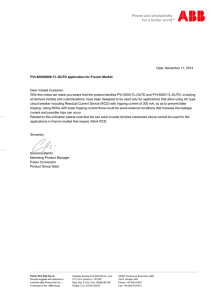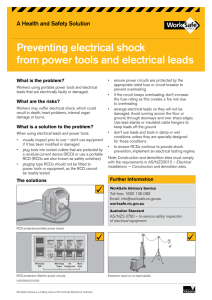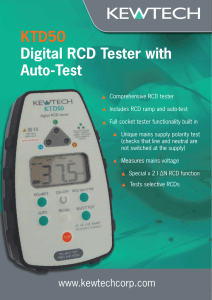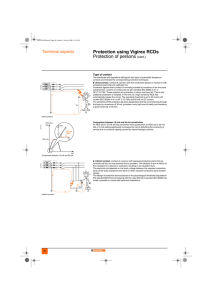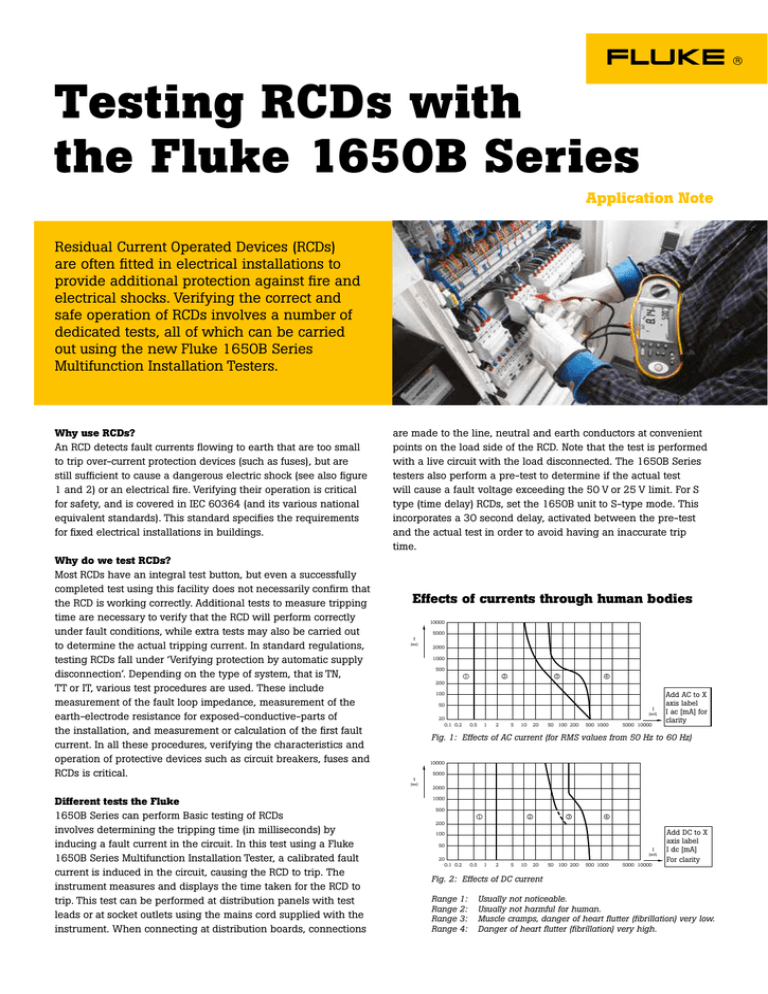
Testing RCDs with
the Fluke 1650B Series
Application Note
Residual Current Operated Devices (RCDs)
are often fitted in electrical installations to
provide additional protection against fire and
electrical shocks. Verifying the correct and
safe operation of RCDs involves a number of
dedicated tests, all of which can be carried
out using the new Fluke 1650B Series
Multifunction Installation Testers.
Testing RCDs with
the Fluke 1650B Series
Why use RCDs?
An RCD detects fault currents flowing to earth that are too small
to trip over-current protection devices (such as fuses), but are
Residual still
Current
Operated
(RCDs)
often fitted
in
sufficient to
cause aDevices
dangerous
electricare
shock (see
also figure
electrical1 installations
to
provide
additional
protection
against
and 2) or an electrical fire. Verifying their operation is critical
fire and electrical
shocks.
Verifying
the correct
and safe
for safety, and
is covered
in IEC 60364
(and its various
national
operationequivalent standards).
of RCDs involves This
a number
dedicatedrequirements
tests, all of
standardof
specifies the
for be
fixed
electrical installations
in new
buildings. which can
carried
out using the
Fluke 1650B Series
Multifunction Installation Testers.
Why do we test RCDs? Most RCDs have an integral test button, but even a successfully
not necessarily
confirm
that
milliseconds)
by inducing
a fault
Why usecompleted
RCDs?test using this facility does
the RCD is working correctly. Additional tests
measure
current in thetocircuit.
In tripping
this test
An RCD detects fault currents
time are necessary to verify thatusing
the RCD
will perform
correctly
a Fluke
1650B Series
flowing to earth that are too small to
under fault conditions, while extra
tests may also
be carried
out a
Multifunction
Installation
Tester,
trip over-current protection devices
to determine the actual tripping calibrated
current. In fault
standard regulations,
current is induced in
(such as fuses), but are still sufficient
testing RCDs fall under ‘Verifyingthe
protection
by automatic supply
circuit, causing
the RCD to trip.
to cause a dangerous electric shock
disconnection’. Depending on the
type
of system,measures
that is TN,and
The
instrument
(see also figure 1 and 2) or an
TT or IT, various test procedures displays
are used. These
the timeinclude
taken for the RCD
electrical fire. Verifying their
measurement of the fault loop impedance,
measurement of
the
to trip. This
test can be performed
at
operation is critical for safety, and is
earth-electrode resistance for exposed-conductive-parts
distribution panels with of
test leads
covered in IEC 60364 (and its
the installation, and measurement
or calculation
of the
firstthe
fault
or at
socket outlets
using
mains
various national equivalent
current. In all these procedures, cord
verifying
the characteristics
and
supplied
with the instrument.
standards). This standard specifies
operation of protective devices such
asconnecting
circuit breakers,
fuses and
When
at distribution
the requirements for fixed electrical
RCDs is critical. boards, connections are made to
installations in buildings.
the line, neutral and earth
Different tests the Fluke conductors at convenient points on
Why do1650B
we test
RCDs?
Series can perform Basicthe
testing
RCDs
loadofside
of the RCD. Note that
Most RCDsinvolves determining
have an integral test
the tripping
by a live
thetime
test(in milliseconds)
is performed with
button, butinducing
even a asuccessfully
fault current in the circuit.
this the
test using
a Fluke
circuitInwith
load disconnected.
completed1650B
test using
this facility
Series Multifunction
Installation
Tester,
a calibrated
fault
The 1650B
Series
testers also
does not necessarily
confirm
that the
current is induced in the
circuit,perform
causing a
the
RCD to to
trip. The
pre-test
determine if
RCD is working
correctly.
Additional
instrument
measures
and displays
timetest
taken
forcause
the RCD to
thethe
actual
will
a fault
tests to measure
tripping
time
are
trip. This test can be performed
at distribution
panels
voltage
exceeding
thewith
50 test
V or 25 V
necessary leads or
to verifyatthat
theoutlets
RCD will
socket
using the
mains cord
supplied
with the
limit.
For S type
(time delay)
RCDs,
perform correctly
under faultconnecting atset
instrument. When
distribution boards,
the 1650B unit toconnections
S-type mode.
conditions, while extra tests may
This incorporates a 30 second delay,
also be carried out to determine the
activated between the pre-test and
actual tripping current. In standard
the actual test in order to avoid
regulations, testing RCDs fall under
having an inaccurate trip time.
are made to the line, neutral and earth conductors at convenient
points on the load side of the RCD. Note that the test is performed
with a live circuit with the load disconnected. The 1650B Series
testers also perform a pre-test to determine if the actual test
will cause a fault voltage exceeding the 50 V or 25 V limit. For S
type (time delay) RCDs, set the 1650B unit to S-type mode. This
incorporates a 30 second delay, activated between the pre-test
and the actual test in order to avoid having an inaccurate trip
time.
Application Note
Effects of currents through human bodies
10000
t
[ms]
5000
2000
1000
500
1
2
3
4
200
100
50
I
20
0.1 0.2
[mA]
0.5
1
2
5
10
20
50 100 200
500 1000
5000 10000
Add AC to X
axis label
I ac [mA] for
clarity
Fig. 1: Effects of AC current (for RMS values from 50 Hz to 60 Hz)
10000
t
[ms]
5000
2000
1000
500
1
2
3
4
200
100
50
I
20
0.1 0.2
[mA]
0.5
1
2
5
10
20
50 100 200
500 1000
5000 10000
Add DC to X
axis label
I dc [mA]
For clarity
Fig. 2: Effects of DC current
Range
Range
Range
Range
1:
2:
3:
4:
Usually not noticeable.
Usually not harmful for human.
Muscle cramps, danger of heart flutter (fibrillation) very low.
Danger of heart flutter (fibrillation) very high.
Manual measurement of RCD tripping time To manually measure the tripping time, a number of parameters
must be entered in the installation tester using the function soft
keys. The following need to be set: • RCD trip-current rating typically 10, 30, 100, 300, 500,
1000 mA or Var (variable test current setting) • Test current multiplier x1/2, x1, x5 or auto • RCD test-current waveform:
- AC current to test Type AC (Standard AC RCD) and Type A
(pulse sensitive RCD*)
- Pulse current to test Type A (pulse sensitive RCD*) - Smooth-DC current to test type B RCD 1 - Delayed response to S-type B
(time delayed smooth-DC current RCD) 1 - Delayed response to test S-Type AC (time delayed AC RCD)
or S-Type A (time delayed pulsesensitive RCD*)
• Test-current phase setting 0° or 180° Note: The European standard IEC 61008-1describes the properties
for RCD. Trip current limits for RCD type A, DC pulse is allowed
between 35% and 140% (even 200% for 10mA RCD type) of the
nominal trip current e.g. for a 30 mA RCD the trip current can be
between 10.5 mA and 42 mA.
* Pulse DC models 1652, 1653 & 1654 only,
1 Smooth-DC 1654 only
Note that because some RCDs are more sensitive in one half cycle
of the mains supply waveform than the other, the test must be
carried out for both zero and 180 degree phase settings, and the
longest time should be recorded. The default setting for the test
current multiplier is ‘x1’ (the 1651B base model has this setting
only), and this tests RCDs at their rated trip current. The measured
tripping time can be compared with the maximum time permitted
by local Regulations or Standards for that type of device. Auto testing To simplify and speed up testing, the 1652C, 1653B & 1654B
models have an auto mode for measuring RCD tripping time in
which six tests (x1/2, x1 and x5 at 0° and 180°) are automatically
carried out in sequence. This eliminates the need for the test
engineer or his assistant to keep returning to the installation tester
after resetting a tripped RCD. This feature saves a considerable amount of time on site. To measure RCD tripping time using Auto
mode on the 1652C, 1653B & 1654B models, the RCD current
rating is again entered with softkeys and the Auto mode selected
using the function softkeys. After entering the RCD type and
initiating the test, the sequence starts by applying x1/2 the RCD’s
current rating for a predetermined period (310, 510 or 2000
ms – depending on local regulations). If the RCD trips, the test is
terminated. If not, the instrument automatically reverses the phase
and repeats the test. Again, if the RCD trips, the test is terminated.
If not, the instrument supplies x1 the RCD’s current rating for 2000
ms. The RCD should now trip and the time is displayed and stored
in memory. After the RCD has been reset, the instrument
reverses phase and repeats the x1 test. The sequence is repeated
with x5 the RCD’s current rating to complete the auto test cycle.
The instrument ‘senses’ when the RCD has been manually reset
and initiates the next test in the sequence. Results are held in
temporary memory, and viewed by stepping through with the
arrow buttons. The 1653B & 1654B also have an internal memory
for storing results for later recall or importing into a report made
using FlukeView Forms or DMS Software. Ramp RCD testing In addition to measuring trip time, the 1652C, 1653B and 1654B
models can also measure RCD tripping current by gradually
increasing an applied current until the RCD trips. This is commonly
referred to as a ramp RCD test. Once again, the RCD trip current
rating, RCD type, and test current phase must be selected using
softkeys before commencing the test.
Variable RCD trip-current setting The new 1650B series covers an additional feature for RCD
testing. To measure RCD tripping current for a custom RCD setting
the VAR mode is available. With the arrow keys a user defined
current can be selected between 10…1000 mA (AC test current)
and 10…700 mA (pulse DC test current*) to adjust the value. Fluke (UK) Ltd.
Fluke. K
eeping your World up and Running.®
© Copyright 2014, Fluke Corporation. All rights reserved.
Data subject to alteration without notice. Pub_ID: 11545-eng.
.
.
.
52 Hurricane Way
Norwich, Norfolk
NR6 6JB
United Kingdom
Tel. +44 (0)20 7942 0700
Fax +44 (0)20 7942 0701
E-mail: industrial@uk.fluke.nl
www.fluke.co.uk

